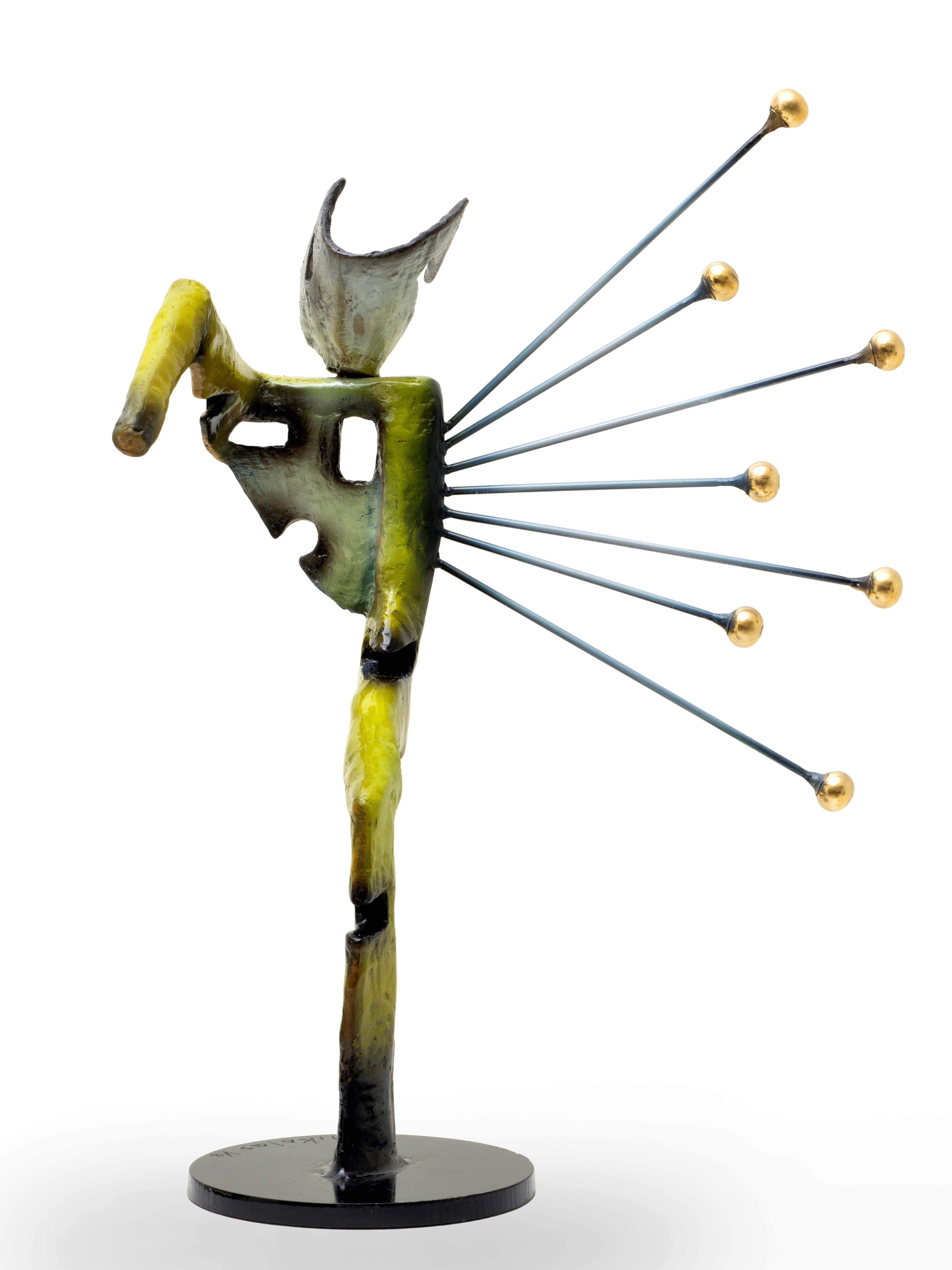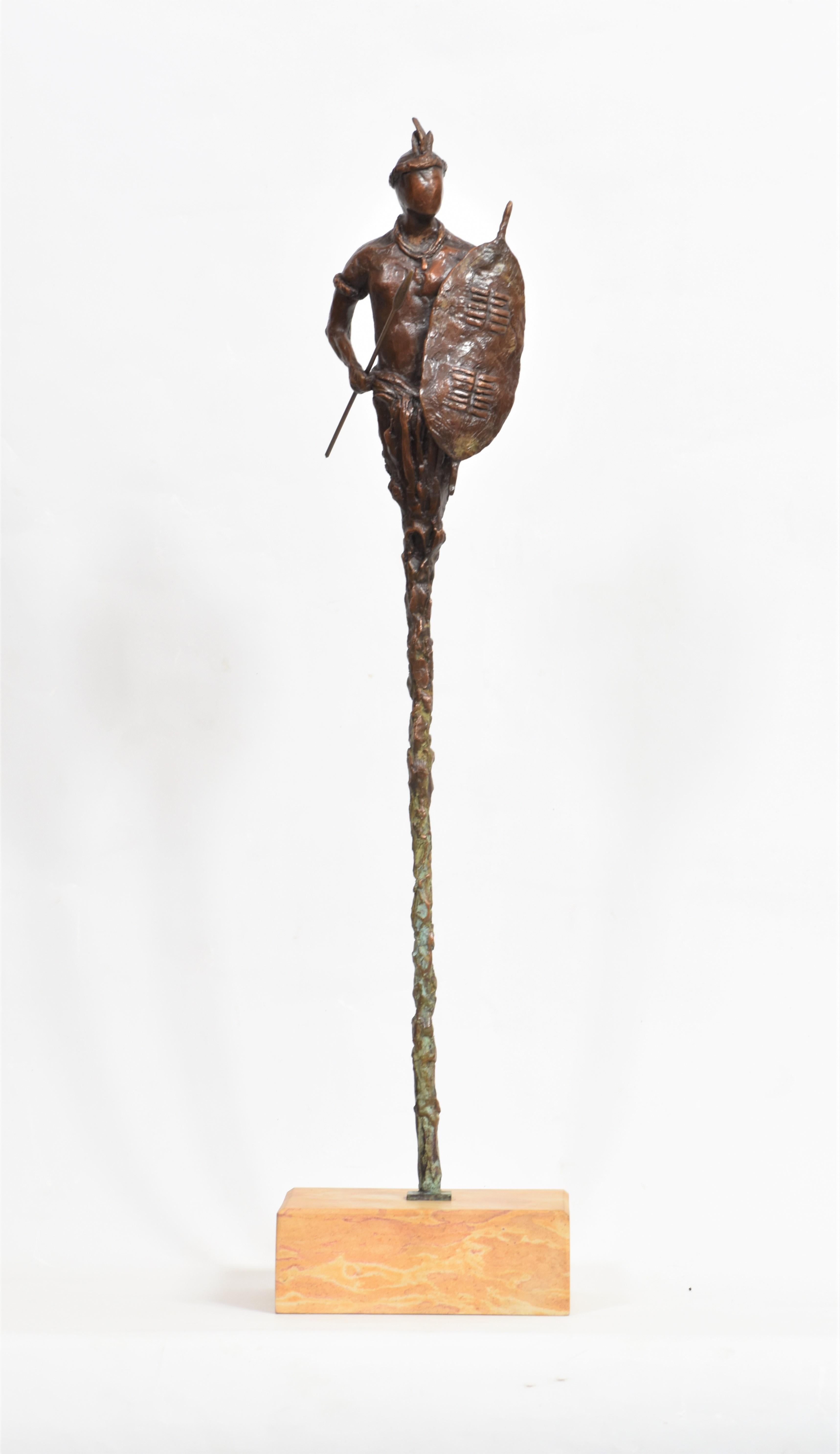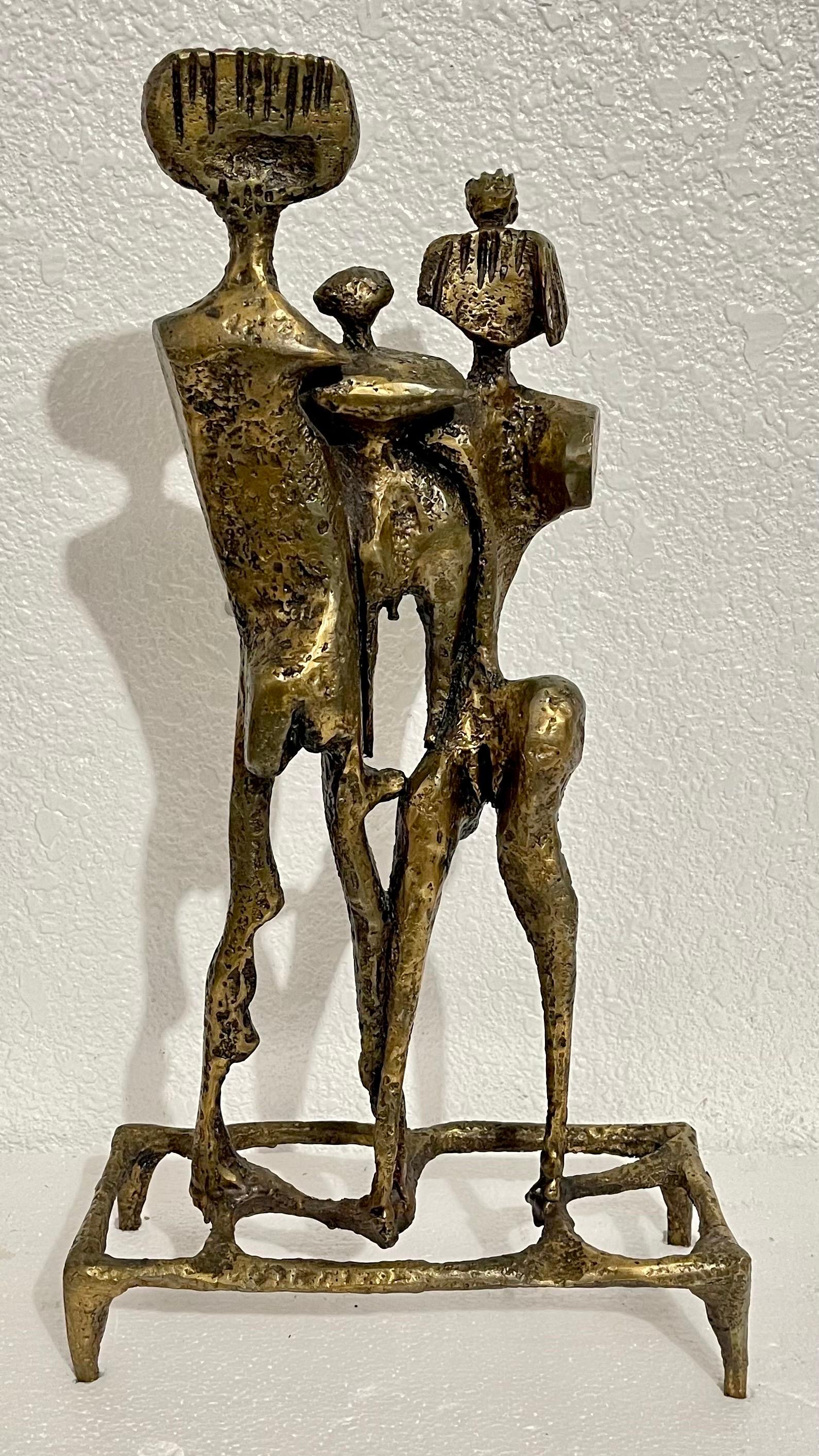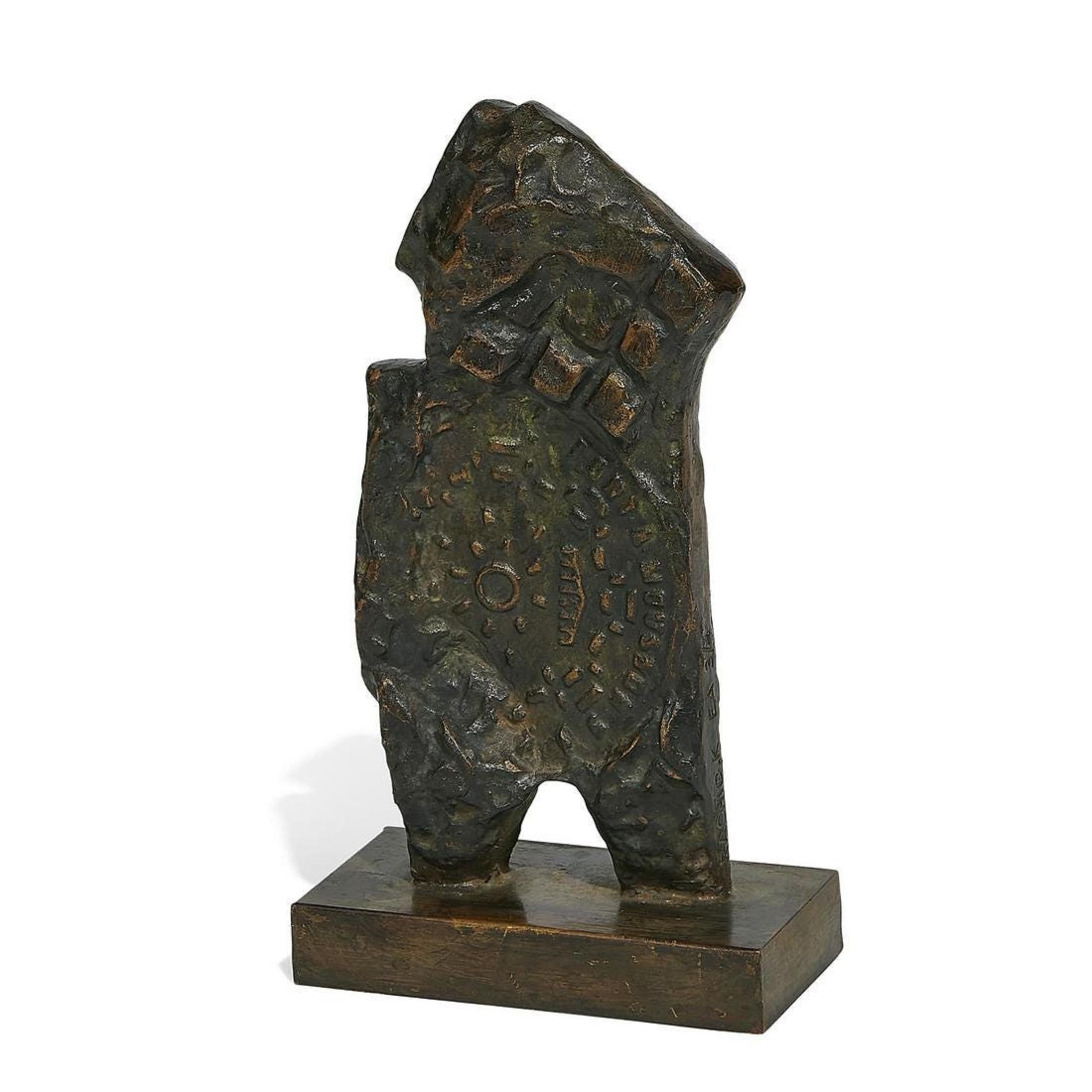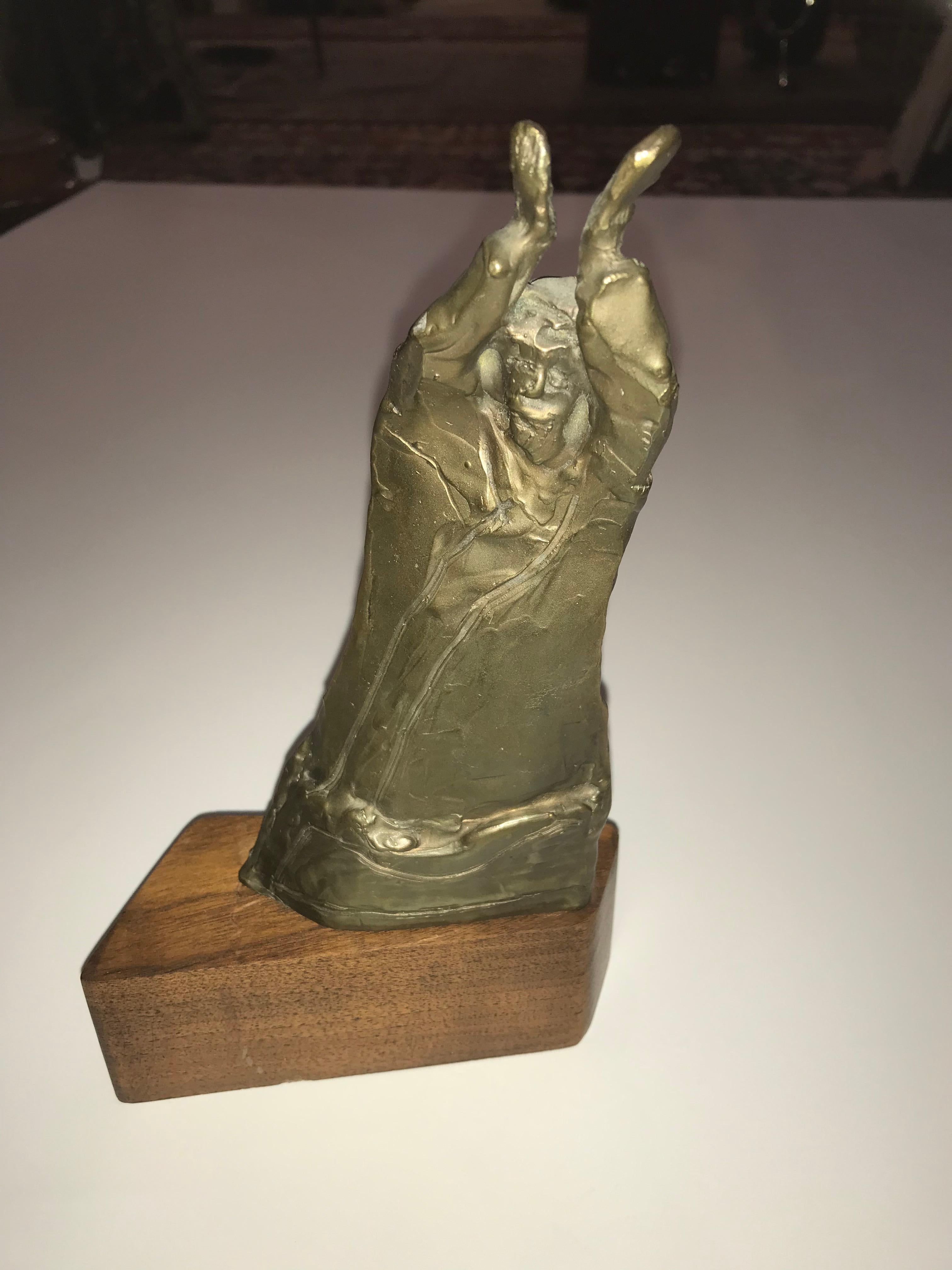Items Similar to Liberty vs Slavery Van Loen Bronze Abstract Chess Set Modernist Museum Sculpture
Want more images or videos?
Request additional images or videos from the seller
1 of 8
Alfred Van LoenLiberty vs Slavery Van Loen Bronze Abstract Chess Set Modernist Museum Sculpturec.1960's
c.1960's
About the Item
Alfred Van Loen signed 32 piece chess set. In heavy solid bronze.
Rare Chess Game: Liberty versus Slavery
Dimensions:
a) Joy-Tenderness H. 6 3/16 in. aa) Bondage H. 5 5/16 in.
b) Play-Security H. 5 5/8 in. bb) Strangulation H. 5 7/8 in.
c) The Scholar H. 7 5/8 in. cc) Hurt Helpless H. 7 in.
d) The United Family H. 10 7/8 in. dd) Prisoner-Imprisoned H. 10 1/4 in.
e) Peace-Freedom H. 9 3/4 in. ee) Nurse-Pity H. 8 5/8 in.
f) Laborer H. 7 5/8 in. ff) Hopeless-Damaged H. 7 in.
g) Game-Confidence H. 5 3/4 in. gg) Brutality-Cruelty H. 6 1/4 in.
h) Pride-Protection H. 6 in. hh) Chained H. 5 in.
i) Drummer H. 4 1/16 in. ii) Wounded H. 4 1/4 in.
j) Clarinetist H. 5 3/4 in. jj) Sick H. 4 9/16 in.
k) Cellist H. 4 3/4 in. kk) Crushed H. 4 3/8 in.
l) Accordionist H. 4 1/2 in. ll) Hopeless H. 4 7/16 in.
m) Cymbal Player H. 4 1/2 in. mm) Beggar H. 3 15/16 in.
n) Guitarist H. 4 11/16 in. nn) Despair H. 4 5/16 in.
o) Harpist H. 4 in. oo) Cripple H. 4 9/16 in.
p) Violinist H. 4 5/16 in. pp) Blind H. 4 5/16 in.
This set is in the permanent collection of the Metropolitan Museum of Art in New York City
and the Israel Museum in Jerusalem. It speaks to the horrors of slavery and the joys of freedom.
it was created during the civil rights movement and while his personal history was of the horrors of World War II, I believe this might also reference the African American experience.
Alfred Van Loen was a prolific artist whose career spanned a half century. He was born in 1924 in Oberhausen-Osterfeld, Germany and sent to Holland to be educated. He graduated from the Royal Academy of Amsterdam. He immigrated to the United States following World War II and taught art at Vassar, Hunter College and Columbia University. He taught at C.W. Post for over 20 years. His work is characterized by a spiritual connection to nature. Van Loen's reputation is built on his works as a direct carver a sculptor who carves into stone or marble without preliminary blueprints, models or drawings. Van Loen is a man in love with the materials. He is an artist who is part scientist, part architect, part explorer and part inventor. Van Loen further isolated himself from the cultural capital and "the sickness of the art world in New York City." Since then, Van Loen has become a bigger star in a smaller galaxy, with a devoted following of patrons and students. Whether casting medals, drawing in unbroken lines (similar to those of Pablo Picasso and Alexander Calder), painting in watercolors or carving stones and wood, Van Loen is the quintessential craftsman. The real Van Loen is in all of his work. He finds endless lines of continuity and form in the trees and birds and plants that surround him. His two lives. One begins in Germany, where he was born in 1924. The other picks up in 1947 when he arrived in New York. At age six, he says, his wealthy, Jewish parents Karl and Hedwig Lowenthal, owners of a sporting good store sent him to school at a Dominican cloister in Venlo, Holland. In 1938, forced to flee Nazi persecution in Germany, the family moved to Amsterdam, where Alfred joined them. A small carved crucifix which he produced caught the eye of a sponsor who enrolled him in the Royal Academy of Art in Amsterdam in 1941. Surrounded by the cruelty and destruction of war, the young artist became involved in the underground, spying and distributing anti-Nazi pamphlets. Betrayed by his best friend, he was arrested by the Nazi Gestapo and spent 16 months in Auschwitz. When he got out, he says, he had only 72 pounds distributed on his 6-foot, 2-inch frame. He did not expect to live after his recovery, he changed his family name, Lowenthal, to Van Loen and returned to the Royal Academy to finish the formal and classical training in anatomy, architectural drawing, pottery, carpentry and casting. By the time he graduated, the war was over, and he decided to come to the United States. When Van Loen talks about this part of his background, the details are sketchy, sometimes contradictory. He does not dwell on that period of his life, and he will not be pressed for specifics. "People should never forget the atrocities of that war," he says. "But they should not continue, living with the memories of it." There are happier memories of his life in the United States, which began April 4, 1947, when a rebuilt troop transport brought 800 emigrants, including the 22-year-old Van Loen, to New York. If there are any gaps in Van Loen's life as a U.S. citizen, they come in the early-1950s when he abandoned the Bohemian life of a young, promising New York artist and traveled to Mexico and briefly to Europe. In 1958, he married Helen Roberts (his second marriage ended in divorce and his first marriage, in pre-war Europe, is shrouded in mystery).
Alfred VAN LOEN (1924-1994) German/Dutch/American
Birth place: Oberhausen-Osterfeld, Germany
Profession: Sculptor, educator
Studied: Royal Acad. Art, Amsterdam, Holland, 1941-46.
Exhibited: PAFA Ann., 1950, 1954, 1960; NAD, 1964; WMAA,1957, 1967; Emil Walters Gal., NYC, 1968; Stony Brook Mus., 1968; Heckshere Mus., Huntington, NY, 1971; Harbor Gal., Cold Spring Harbor, NY, 1970s. Awards: first prize, Village AC, 1949; Louisa Robbins Award, Silvermine Guild Artists, 1956; first prize sculpture, Am. Soc. Contemporary Artists, 1964.
Member: AEA; Am. Soc. Contemp Artists; Am. Crafts Council; Long Island Univ. Pioneer Club; Huntington Artists Group.
Work: MMA; MoMA; Brooklyn Mus., NY; Nat. Mus., Jerusalem, Israel. Commissions: brass fountain, James White Community Center, Salt Lake City, UT, 1958; Peace Window, Community Church, New York, 1963; Crescendo, State Univ. NY Agric. & Tech. College Farmingdale, 1969; Jacob's Dream (brass), Little Neck Jewish Center, NY, 1970; bronze & acrylic portrait of Guy Lombardo, Hall of Fame, Stony Brook, NY, 1972.
Preferred media: stone, acrylic.
Publications: "Simple Methods of Sculpture," Channel Press, 1958; "Instructions to Sculpture," C.W. Post College, 1966;
"Origin of Structure and Design," Hamilton Press, 1967;
"Drawings by Alfred Van Loen," Harbor Gallery Press, 1969.
Teaching: instructor, Hunter College, 1953-54
instructor, North Shore Community ACr., NY, 1955-61;
asst. professor sculpture, C.W. Post College, Long Island Univ., 1962-.
- Creator:Alfred Van Loen (1924 - 1994, American)
- Creation Year:c.1960's
- Dimensions:Height: 21.5 in (54.61 cm)Width: 7 in (17.78 cm)
- Medium:
- Movement & Style:
- Period:
- Condition:
- Gallery Location:Surfside, FL
- Reference Number:1stDibs: LU3826558072
About the Seller
4.9
Platinum Seller
These expertly vetted sellers are 1stDibs' most experienced sellers and are rated highest by our customers.
Established in 1995
1stDibs seller since 2014
1,541 sales on 1stDibs
Typical response time: 1 hour
- ShippingRetrieving quote...Ships From: Surfside, FL
- Return PolicyA return for this item may be initiated within 3 days of delivery.
More From This SellerView All
- Large Aharon Bezalel Israeli Modernist Bronze Brutalist Puzzle Sculpture FiguresBy Aharon BezalelLocated in Surfside, FLAharon Bezalel (Afghani-Israeli, 1925-2012) 1984 Edition 4/9 Family Grouping Hand signed in Hebrew with initials and in English Movable figures that fit together like puzzle pieces in solid cast bronze with original patina on a lucite bench base. 23 X 19 X 6 base is 24 X 6 X 6 Aharon Bezalel (born Afghanistan 1926) Born in Herat, Afghanistan in 1926 and immigrated to Israel at an early age. His father, Reuven Bezalel, was a rabbi and kabbalist. As a youth Aharon studied gold and silver casting as well as applied arts and worked in these fields as a silversmith and judaica craftsman, and was a student of the sculptor Zev Ben-Zvi at the Bezalel Academy for Art & Design where he also studied with Isidor Ascheim and Mordecai Ardon. There he absorbed the basic concepts of classic and modernist art and interpreted, according to them, ideas based on ancient Hebrew sources. He also studied miniature carving with the artists Martin and Helga Rost applying himself at their workshop. Aharon Bezalel worked and resided in Jerusalem, he taught art for many years. His sculptures - works of wood, bronze, aluminum, Plexiglas - were shown at his studio in Ein Kerem. “I saw myself as part of this region. I wanted to find the contact between my art and my surroundings. Those were the first years of Jean Piro’s excavations at the Beer-Sheba mound. They found there, for example, the Canaanite figurines that I especially liked and that were an element that connected me with the past and with this place.” “…a seed and sperm or male and female. These continue life. The singular, the individual alone, cannot exist; I learned this from my father who dabbled with the Kabbalah.” (Aharon Bezalel, excerpt from an interview with David Gerstein) “The singular in Aharon Bezalel’s work is always potentially a couple if not a threesome, the one is also the many: when the individual is revealed within the group he will always seek a huddling, a clinging together. The principle of modular construction is required by this perception of unity and multiplicity, as modular construction in his work is an act of conception or defense. His work bears a similarity to Berrocal as well as affinities to Henry Moore, Lynne Chadwick and Kenneth Armitage. Two poles of unity, potentially alone, exist in A. Bezalel’s world: From a formal, sculptural sense these are the sphere and pillar, metaphorically these are the female in the final stages of pregnancy and the solitary male individual. Sphere-seed-woman; Pillar-strand-man. The disproportional, small heads in A. Bezalel figures leave humankind in it’s primal physical capacity. The woman as a pregnancy or hips, the man as an aggressive or defensive force, the elongated chest serves as a phallus and weapon simultaneously. (Gideon Ofrat) EIN HAROD About the Museum's Holdings: Israeli art is represented by the works of Reuven Rubin, Zaritzky, Nahum Gutman...Category
Mid-20th Century Expressionist Abstract Sculptures
MaterialsBronze
- Large Aharon Bezalel Israeli Modernist Bronze Brutalist Puzzle Sculpture FiguresBy Aharon BezalelLocated in Surfside, FLAharon Bezalel (Afghani-Israeli, 1925-2012) Family Grouping Hand signed in with initials in English Figures fit together like puzzle pieces in solid cast bronze with original patina. Aharon Bezalel (born Afghanistan 1926) Born in Herat, Afghanistan in 1926 and immigrated to Israel at an early age. His father, Reuven Bezalel, was a rabbi and kabbalist. As a youth Aharon studied gold and silver casting as well as applied arts and worked in these fields as a silversmith and judaica craftsman, and was a student of the sculptor Zev Ben-Zvi at the Bezalel Academy for Art & Design where he also studied with Isidor Ascheim and Mordecai Ardon. There he absorbed the basic concepts of classic and modernist art and interpreted, according to them, ideas based on ancient Hebrew sources. He also studied miniature carving with the artists Martin and Helga Rost applying himself at their workshop. Aharon Bezalel worked and resided in Jerusalem, he taught art for many years. His sculptures - works of wood, bronze, aluminum, Plexiglas - were shown at his studio in Ein Kerem. “I saw myself as part of this region. I wanted to find the contact between my art and my surroundings. Those were the first years of Jean Piro’s excavations at the Beer-Sheba mound. They found there, for example, the Canaanite figurines that I especially liked and that were an element that connected me with the past and with this place.” “…a seed and sperm or male and female. These continue life. The singular, the individual alone, cannot exist; I learned this from my father who dabbled with the Kabbalah.” (Aharon Bezalel, excerpt from an interview with David Gerstein) “The singular in Aharon Bezalel’s work is always potentially a couple if not a threesome, the one is also the many: when the individual is revealed within the group he will always seek a huddling, a clinging together. The principle of modular construction is required by this perception of unity and multiplicity, as modular construction in his work is an act of conception or defense. His work bears a similarity to Berrocal as well as affinities to Henry Moore, Lynne Chadwick and Kenneth Armitage. Two poles of unity, potentially alone, exist in A. Bezalel’s world: From a formal, sculptural sense these are the sphere and pillar, metaphorically these are the female in the final stages of pregnancy and the solitary male individual. Sphere-seed-woman; Pillar-strand-man. The disproportional, small heads in A. Bezalel figures leave humankind in it’s primal physical capacity. The woman as a pregnancy or hips, the man as an aggressive or defensive force, the elongated chest serves as a phallus and weapon simultaneously. (Gideon Ofrat) EIN HAROD About the Museum's Holdings: Israeli art is represented by the works of Reuven Rubin, Zaritzky, Nahum Gutman...Category
Mid-20th Century Expressionist Abstract Sculptures
MaterialsBronze
- Rachid Khimoune French Algerian Arab Art Brut Bronze Sculpture Abstract FigureLocated in Surfside, FLRachid Khimoune (Algerian, b. 1953) Les enfants du monde bronze. signed and numbered artist's edition of 4 foundry mark - L. Cappe 7.5 x 4.63 x 2.38 Overall: 8.25 x 4.63 x 2.38 RACHID KHIMOUNE, Algerian-French artist and sculptor. Born in 1953 in Decazeville, France. Lives and works in Paris, France. Rachid Khimoune graduated from the School of Art of Paris in 1974; he initially started to work with painting before choosing sculpture. In 1980 he won the first prize of the Foundation of France. He works in an Art Brut, Naif art style similar to Jean Dubuffet and Enrico Baj. Being the recipient of numerous prestigious awards and an extensive oeuvre, Rachid Khimoune has been exhibiting since 1975 and his work can be found in several museums, and public and private collections. The artist behind the project Rachid Khimoune, has been responsible for a number of major, successful public art installations in France. Most famously, the installation close to the Bibliothèque Nationale (National Library) ‘Les Enfants du Monde’ (The Children of the World). Rachid’s newer works are masks and totems cast in bronze: poetic images forged in a furnace. Rachid uses discarded objects and disused parts of machines, to create new human and animal forms. Here his interest in metal-working and Arab art-African art coincides with the assemblage of found objects; one mask is a collage constituted by a large model of the Eiffel Tower stuck into the end of a trumpet. Another has a jerry-can for a face, and the golden patina and surface-working of the bronze does not dispel the idea which this image creates: of a human mouth drinking oil. Born in France to parents from Algeria, Khimoune embraces the role of the artist as a global citizen, using art as a universal language. Select Awards Lauréat du Prix de la Fondation de France (1980) Chevalier des Arts et Lettres (2002) Grande Médaille de la Ville de Paris (2004) Chevalier de la Légion d’Honneur (2007) EXHIBITIONS SOLO EXHIBITIONS 2017 Ar[T]senal, Dreux, France 2016 Musée Tavet Delacour, Pontoise, France 2015 Parvis de l’Hotel de ville, Paris 2015 Beirut Art Fair, Beyrouth, Liban 2015 Galerie Francoise Souchaud, Lyon 2014 Musée Rabelais, Seuilly, France 2013 Galerie Vallois...Category
20th Century Expressionist Abstract Sculptures
MaterialsBronze
- Carved Wood German Expressionist Sculpture Jewish Woman Refugee Artist JudaicaBy Miriam SommerburgLocated in Surfside, FLMiriam Sommerburg (American female artist, born Germany, Hamburg, 1900–1980 New York) Modernist Wood Carved Sculpture, Carving depictin...Category
Mid-20th Century Expressionist Figurative Sculptures
MaterialsWood
- Bronze Sculpture Abstract Brutalist Goat or Ram WPA Artist Mounted on BaseBy Benedict Michael TattiLocated in Surfside, FLBenedict Tatti (1917-1993) worked in New York city as a sculptor, painter, educator, and video artist. He studied stone and wood carving under Louis Slobodkin at the Roerich Museum. He later attended the Leonardo da Vinci School of Art studying under Attilio Piccirelli. In l939 he taught adult classes with the Teachers Project of the WPA and attended the Art Students League for three and a half years on full scholarship. He studied under William Zorach and Ossip Zadkine and later became Zorach’s assistant. Later in his career, he attended the Hans Hofmann School of Fine Arts. During World War II, Tatti served in the United States Army Air Force, where he spent three years assigned to variety of projects. In 1948, Benedict Tatti married Adele Rosenberg in New York City. Throughout his career, Tatti continuously experimented with various media. From 1952-1963, Tatti executed sculptural models of architectural and consumer products for the industrial designers, Raymond Loewy Associates; later he became a color consultant for the firm. In the 1960s, influenced by the Abstract Expressionists, Tatti turned from carving directly in wood and stone to creating assemblage architecture sculptures, using bronze metal and other industrial materials. He was included in the important show "Aspects de la Sculpture Americaine", at Galerie Claude Bernard Paris, France, in October 1960 along with Ibram Lassaw, Theodore Roszak, David Smith, Louise Bourgeois, Danese Corey, Dorothy Dehner, Lin Emery...Category
Mid-20th Century Abstract Expressionist Abstract Sculptures
MaterialsBronze
- Large Art Moderne Bronze Sculpture Esther Wertheimer Mother Baby Child Art DecoLocated in Surfside, FLEsther Wertheimer ( Polish, Canadian 1926 - 2016 ) Hand signed Wertheimer Dimensions: 14.5 X 8 X 5.75 in. This semi abstract figurative bronze scul...Category
20th Century Modern Figurative Sculptures
MaterialsMarble, Bronze
You May Also Like
- HomodeusLocated in Spetses, GRInspired by the writings of historian Yuval Noah Harari, Homo Deus creates a vision of the future: of Man physically transformed by new technologies to the point of attaining a statu...Category
21st Century and Contemporary Expressionist Abstract Sculptures
MaterialsBronze
- Zulu Warrior - African Bronze Sculpture - Limited EditionLocated in Pretoria, ZAZulu Warrior in Bronze with traditional patina. Limited edition of 24 (signed & numbered), Sculpture in Bronze Verdigris on Sandstone base. Height 70 cm including base. My art is ins...Category
2010s Expressionist Figurative Sculptures
MaterialsSandstone, Bronze
- Standing Man by Mildred KouzelLocated in Pasadena, CAOriginal Art Work By California Recent Artist Standing Man, 1981 Mildred Kouzel's first career was in nursing: she was an army nurse during World War II...Category
Mid-20th Century Expressionist Figurative Sculptures
MaterialsBronze
- Zulu Warrior - African Sculpture in Bronze Verdigris - Limited EditionLocated in Pretoria, ZAZulu Warrior in Bronze Verdigris, limited edition of 24 (signed & numbered), Sculpture in Bronze Verdigris on Sandstone base. Height 70 cm including base. My art is inspired by Afric...Category
2010s Expressionist Figurative Sculptures
MaterialsBronze
- Samburu Herdsman - African Tribe Sculpture in Bronze VerdigrisLocated in Pretoria, ZAMy interpretation of a Samburu herdsman stands as a sentinel of tradition, his life a tapestry woven with the threads of pastoral wisdom and the enduring spirit of the African savannah. The Samburu people of Kenya possess a deeply symbiotic relationship with elephants, observing and understanding them in remarkable ways that mirror their own societal structures. They share a common matriarchal social system with elephants, where both Samburu and elephant herds are led by a female elder who holds the knowledge and responsibility for the group's survival. This unique parallel has fostered a profound respect and protection for these majestic creatures within the Samburu culture. Samburu Herdsman, Limited edition of 24, Bronze sculpture on sandstone base in Bronze Verdigris, Height 65 cm including Sandstone base. Bronze sculpture using the lost was method. My art is inspired by Africa and it’s magnificent wildlife and people. My figurative East African tribal sculpture...Category
2010s Expressionist Figurative Sculptures
MaterialsBronze
- Maasai Warrior - African Sculpture in Bronze Verdigris - Limited EditionLocated in Pretoria, ZAMaasai Warrior in Bronze Verdigris on Sandstone base, limited edition of 24 (signed and numbered); H 76 cm including base. Having been a professional safari guide, my art is influenc...Category
2010s Expressionist Figurative Sculptures
MaterialsSandstone, Bronze
Recently Viewed
View AllMore Ways To Browse
Museum Carved
Set Of Two Sculptures
Wood Vaneer
Ny 1970s
Wood Sculpture Set
Bronze Brass Sculpture
Church Sculpture
Small Brass Sculpture
16century Sculpture
Abstract Bird Sculpture
White Classical Sculpture
1950s Bronze Art
Modernist Wood Sculpture
Foot Sculpture Bronze
Chess Sets
Chess Set
1970s Abstract Modernist
Small Eye Sculpture

